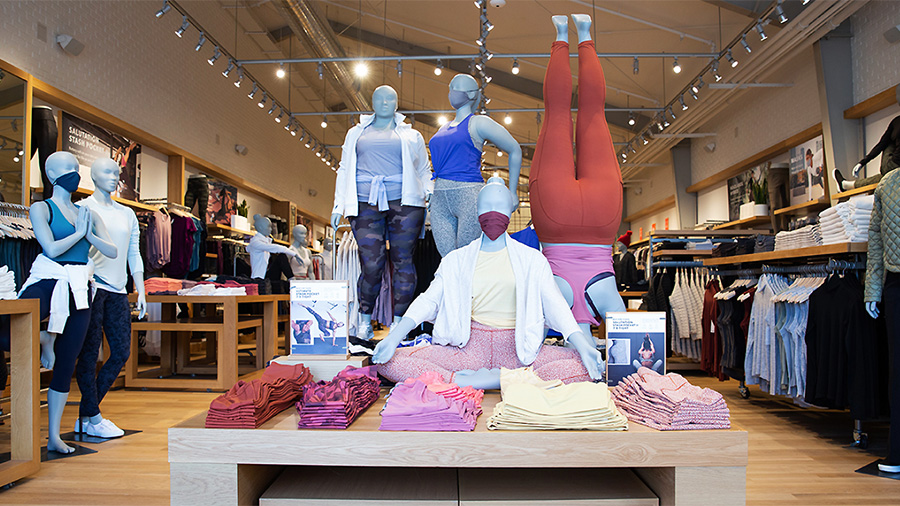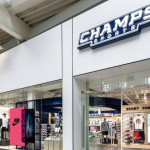Gap Inc. reported comparable sales at its Athleta chain increased two percent year-over-year and 41 percent versus 2019. Companywide, Gap slashed its full-year guidance due to shipment delays.
Net sales in the third quater were up 48 percent versus 2019.
Gap said as part of its plan to reach $2 billion in sales, Athleta continues to invest in new touchpoints to increase awareness and drive customer engagement.
During the quarter, the company expanded its footprint launching its Canadian online business at the end of August and opening its first company-operated Canadian store in Vancouver at the end of September, followed by its second store, which opened in Toronto last week. Gap said the brand is laying the foundation for greater international expansion with franchise partnerships in Costa Rica and Europe. Last month, it released its first item with Simone Biles, a limited-edition Girl’s hoodie, with a broader collection planned for Spring 2022.
Companywide, Gap slashed its full-year outlook as fiscal third-quarter results fell short as COVID-related factory closures led to significant product delays in the quarter. The company’s third quarter fiscal year 2021 net sales of $3.9 billion were down 1 percent compared to 2019 with supply chain disruption driving an estimated 8 percentage point negative impact due to constrained inventory. Wall Street’s consensus estimate had been $4.44 billion.
Gap said global supply chain disruptions, including COVID-related factory closures and continued port congestion, caused significant product delays in the third quarter. Meaningfully reduced inventory positions throughout the quarter negatively impacted sales as brands were unable to fully meet consumer demand. The company noted that while supply chain constraints continue, it is leveraging increased air freight and port diversification to navigate ongoing delivery challenges for holiday.
The company said it remains focused on digital dominance through investing in its e-commerce platform, closing unprofitable stores and partnering to amplify in international markets. Online sales grew 48 percent compared to the third quarter of 2019 and represented 38 percent of the total business, even as store traffic continues to rebound. Gap said investments in technology are driving an enhanced online experience as the company accelerates its digital strategy. Third-quarter comparable sales were up 5 percent versus 2019. The comparable sales calculation reflects online sales and comparable sales days in stores that were open.
Net sales and comparable sales by global brands outside Athleta for the quarter were as follows:
- Old Navy: Net sales were up 8 percent versus 2019. Comparable sales were down 9 percent year-over-year and increased 6 percent versus 2019. Sales in the quarter outpaced available inventory as the brand was disproportionately impacted by supply chain delays, particularly within the women’s assortment. Following the launch of BodeQuality, Old Navy’s extended-size customer file has doubled since last quarter, with 15 percent of extended-size customers being new to the brand. These customers are increasingly shopping for the family across multiple categories, driving an increase in average transaction value.
- Gap: Net sales declined 10 percent versus 2019, with permanent store closures resulting in an estimated 18 percent net sales decline. Global comparable sales increased 7 percent year-over-year and increased 3 percent versus 2019. North America two-year comparable sales were positive for the third consecutive quarter, up 13 percent versus 2019, with net sales only one percent below 2019 levels despite nearly 190 store closures in the region since the third quarter of 2019. To date, Gap has entered into partnership agreements in the UK, Ireland, France, and Italy, which are expected to improve the profitability of its European business. The brand’s Partner to Amplify strategy continues to ignite relevance with the launch of the Yeezy Gap Hoodie delivering the most sales by an item in a single day in Gap.com history with 70 percent of customers being new to the brand. Additionally, the launch of a second Gap Home collection at Walmart.com has expanded its assortment to include furniture and rugs.
- Banana Republic:Net sales declined 18 percent versus 2019, with permanent store closures resulting in an estimated 10 percent sales decline. Comparable sales increased 28 percent year-over-year and decreased 10 percent versus 2019. Following the brand’s relaunch in September, Banana Republic is focused on improving every touchpoint of the customer experience – including elevated high-quality product, differentiated omni experiences, and relevant marketing. Banana Republic was able to expand product margins in the quarter compared to both last year and 2019 through lower discount rates and higher selling prices.
Third Quarter 2021 Additional Results
(compared to the third quarter of fiscal 2019)
- Reported gross margin of 42.1 percent increased 310 basis points versus 2019. Excluding a benefit related to transitioning the company’s European business to a partnership model, the adjusted gross margin was 41.9 percent, an increase of 290 basis points driven by:
- Rent, Occupancy and Depreciation (ROD) leverage of 300 basis points versus 2019 due to online growth, strategic store closures and rent negotiations; and
- Merchandise margins were down just 10 basis points versus 2019 as strong product acceptance offset nearly 200 basis points of online shipping costs and about 250 basis points of short-term headwinds related to air freight.
- Operating expenses were $1.51 billion or 38.2 percent of net sales on a reported basis. Excluding a charge of $26 million related to transitioning the company’s European business to a partnership model, adjusted operating expenses were $1.48 billion or 37.6 percent of net sales, 610 basis points higher than 2019 adjusted operating expenses. The third-quarter rate reflects an increased investment in marketing to support new initiatives, investments in technology to build out digital and supply chain capabilities, and higher incentive compensation and fulfillment expenses, partially offset by reductions in store expenses.
- Operating margin for the quarter was 3.9 percent on a reported basis. Adjusted operating margin of 4.3 percent decreased 320 basis points compared to 2019 adjusted operating margin and includes an estimated $300 million in lost sales due to constrained inventory, as well as approximately $100 million in transitory air freight costs.
- During the quarter, the company restructured its long-term debt by retiring $2.25 billion of senior secured notes and issuing $1.5 billion of lower coupon senior unsecured notes, which is anticipated to generate approximately $140 million in annual interest expense savings. Interest, net for the quarter was $43 million. In conjunction with the long-term debt restructuring, the company incurred a loss on extinguishment of debt of $325 million.
- The effective tax rate for the third quarter was 29.3 percent. Excluding the net impact related to strategic changes in the company’s European business and loss on extinguishment of debt, the adjusted effective tax rate was 19.7 percent.
- On a reported basis, the diluted loss per share was $0.40. Excluding fees associated with our long-term debt restructuring and the transition of our European markets to a partnership model, adjusted earnings per share for the quarter were $0.27. Wall Street’s consensus estimate for adjusted earnings were 50 cents.
- During the quarter, the company repurchased 2.9 million shares for $73 million and ended the third quarter of fiscal year 2021 with 374 million shares outstanding.
- The company paid a dividend of $0.12 per share during the third quarter of fiscal year 2021. In addition, on November 10, 2021, the company announced that its Board of Directors authorized a fourth-quarter dividend of $0.12 per share.
- Third-quarter ending inventory was down one percent year-over-year and flat versus 2019. The company expects fourth-quarter ending inventory to be up high single digits versus last year, although this outlook may change given continued volatility in the supply chain.
- The company ended the third quarter of fiscal year 2021 with $1.1 billion in cash, cash equivalents, and short-term investments. Year-to-date free cash flow, defined as net cash from operating activities less purchases of property and equipment, was $196 million.
- Fiscal year-to-date capital expenditures were $486 million.
- The company ended the third quarter of fiscal year 2021 with 3,459 store locations in over 40 countries, of which 2,873 were company operated.
Additional information regarding adjusted gross margin, adjusted operating expenses, adjusted operating margin, adjusted effective tax rate, and free cash flow, all of which are non-GAAP financial measures, is provided at the end of this press release along with a reconciliation of these measures from the most directly comparable GAAP financial measures.
2021 Outlook
The company now expects its reported full-year diluted earnings per share to be in the range of $0.45 to $0.60, which includes a $325 million loss on extinguishment of debt and approximately $120 million in net charges primarily related to divestitures and changes to its European operating model. Excluding these charges, adjusted full-year diluted earnings per share are expected to be in the range of $1.25 to $1.40, which contemplates a range of on-time delivery rates for our holiday flows and other supply chain challenges. Previous guidance called for earnings in the range of $2.10 and $2.25. This guidance includes an estimated $550 to $650 million of lost sales from supply chain constraints on available inventory AND approximately $450 million in total air freight expense for the year. The company noted that when adjusting for transitory costs and sales lost from the acute disruption, the business momentum is strong.
- Net Sales: The company now expects full-year revenue growth to be about twenty percent versus fiscal year 2020, down from prior guidance calling for a 30 percent increase.
- Operating Margin:The company now expects its reported operating margin for fiscal year 2021 to be about 4.5 percent, with adjusted operating margin expected to be about 5 percent, on track to achieving a 10 percent operating margin by the end of 2023.
- Interest Expense, Net: The company expects a full-year net interest expense of $163 million, down $47 million versus prior guidance, which reflects lower interest rates for the third and fourth quarters and a reduction in the company’s overall debt balance.
- Effective Tax Rate: The company now expects its reported fiscal year 2021 effective tax rate to be about 23 percent. Excluding the net impact related to divestitures, strategic changes to its European business and loss on extinguishment of debt, the company expects its adjusted fiscal year 2021 effective tax rate to be about 26 percent.
- Capital Expenditures: The company continues to expect capital spending to be approximately $800 million in fiscal year 2021. Consistent with the company’s Power Plan 2023 strategy, capital spending is expected to primarily support growth investments including digital, loyalty, and supply chain capacity projects, along with investment in store growth for Old Navy and Athleta.
- Real Estate:The company continues to expect to open about 30-40 Old Navy and 20-30 Athleta stores in 2021, as well as close approximately 75 Gap and Banana Republic stores in North America.
“While there is still hard work ahead to navigate near-term challenges in the macro-environment, the team has made tremendous progress, adapting quickly while never taking their focus off of our long-term objectives,” said Katrina O’Connell, Executive Vice President and Chief Financial Officer, Gap Inc. “We have strong demand for our brands and our fleet rationalization and divestitures are progressing well and adding value. Our operating margin remains on track to hit 10 percent by 2023, in line with our plan, even as we navigate these near-term disruptions. While our mitigation efforts are driving significant transitory costs, we view these as investments in preserving market share and driving overall health and relevance for our brands.”
Photo courtesy Athleta














